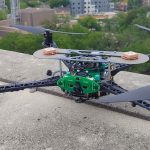For the complete story, including figures, graphs, and images, please download the PDF of the article, above.
Integer carrier-phase ambiguity resolution is the key to fast and high-precision GNSS positioning and navigation. It is the process of resolving the unknown cycle ambiguities of the carrier-phase data as integers. Once this has been done successfully, the very precise carrier-phase data will act as pseudorange data, thus making very precise positioning and navigation possible.
For the complete story, including figures, graphs, and images, please download the PDF of the article, above.
Integer carrier-phase ambiguity resolution is the key to fast and high-precision GNSS positioning and navigation. It is the process of resolving the unknown cycle ambiguities of the carrier-phase data as integers. Once this has been done successfully, the very precise carrier-phase data will act as pseudorange data, thus making very precise positioning and navigation possible.
Procedures for carrier-phase ambiguity resolution not only consist of integer ambiguity estimation, but usually also include ambiguity acceptance testing. Such testing is important, in particular in light of the ever increasing integrity demands on GNSS solutions.
Although the statistical theory of integer ambiguity estimation is reasonably well established, this cannot yet be said of ambiguity acceptance testing. The aim of this article, therefore, is to present a unifying theoretical framework for ambiguity estimation and testing. It provides the tools for comparing and evaluating current procedures for acceptance testing and creates the possibility to devise new tests that are better than existing ones.
We will begin with a review of the four-step procedure for integer ambiguity resolution, including acceptance testing. Next, we will introduce the principle of integer aperture (IA) estimation and explain how and why this estimation principle provides us the framework we are looking for.
The following section will describe how we can evaluate the quality of IA estimation. Finally, we will discuss the way in which to define optimal IA estimators. Two such optimal IA estimators are presented, the fail-rate constrained maximum success-rate estimator and the minimum mean penalty estimator.
The Four Steps of Ambiguity Resolution
To describe the process for resolving carrier-phase ambiguities, we start with the mixed integer linear(ized) GNSS model,
E(y) = Aa + Bb, D(y) = Qyy, a ∈ Zn, b ∈ Rp
where E(.) and D(.) denote expectation and dispersion, respectively, and where the m-vector y contains the “observed minus computed,” single-, dual- or multi-frequency carrier-phase and pseudorange (code) observables. The n-vector a contains the integer double-differenced (DD) ambiguities, and the real-valued p-vector b contains the remaining unknown parameters, such as baseline components (coordinates), atmospheric delay parameters (troposphere, ionosphere), and possibly (receiver, satellite) clock parameters and instrumental delays. Note that the parameterization in DD ambiguities does not require y to be in DD form.
Thus, y may be in undifferenced or single-differenced form as well. The m × (n+p) matrix (A,B) contains the given design matrices of a and b, respectively, and the m×m positive definite matrix Qyy is the variance matrix of y.
The process of solving the GNSS model is usually divided into the following four steps (Figure 1, see inset photo, above right).
1. Float Solution. In the first step, the integer nature of the ambiguities is discarded and a standard least-squares (LS) parameter estimation is performed. As a result, one obtains the so-called float solution, together with its variance-covariance matrix …
2. Integer solution: In the second step, the real-valued float ambiguity solution is further mapped to an integer solution …
3. Accept/Reject. Once integer estimates of the ambiguities have been computed, the third step consists of deciding whether or not to accept the integer solution. Several such tests have been proposed in the literature and are currently in use in practice. Examples include the ratio-test, the F-ratio test, the difference-test and the projector-test (See the 2005 article by S. Verhagen referenced in Additional Resources for a fuller discussion of these tests.) …
4. Fixed Solution. Once the integer solution has been accepted, the float estimator is further adjusted to obtain the so-called fixed estimator …
Although the statistical theory of integer ambiguity estimation (second step) is reasonably well established, for a long time no such theory was available for the third step. Consequently, a proper treatment of the accept/reject decision lags behind the level at which the second step is treated in practice. This has resulted in ad hoc approaches to the third step, in an absence of a proper quality description, and sometimes even in a misunderstanding of its essence.
The goal of our discussion here, therefore, is to present a unifying framework for ambiguity resolution — one that has Step 3 integrally included. The framework is based on the principle of integer aperture estimation as introduced by P. J. G. Teunissen in his 2003 Journal of Planetary Geodesy article cited in Additional Resources.
This framework allows one to answer such questions as:
(i) What is the exact role played by Step 3?
(ii) How can we describe and evaluate its performance?
(iii) How do the different current procedures compare?
(iv) Do tests exist that are better than the current ones?
Integer Aperture Estimation
IA estimation unifies the two steps of integer estimation (Step 2) and testing (Step 3). This approach takes the float solution as input and maps it to either an integer solution or to itself …
… Importantly, the principle of IA-estimation also generalizes all current ambiguity acceptance tests. That is, each such test procedure, such as the ratio-test, the F-ratio test, the difference-test, or the projector-test, is a member of the class of IA-estimators …
… Note that testing the closeness of the float solution to its nearest integer is not the same as testing the correctness of the ILS solution. Thus the ratio-test does not test for the correctness of the ILS solution, as is sometimes erroneously stated in the literature …
Quality of IA-Estimation
To evaluate the performance of an IA-estimator … three outcomes need to be distinguished …
… The above foregoing probabilities may now be used to evaluate any IA-estimator, including those that are currently in use. Additionally, these probabilities may be used to develop new strategies for current IA-estimators …
… This fixed fail-rate strategy gives users control over the fail-rate of their ambiguity resolution. And when applied to current IA-estimators, it provides an improvement over the way the tolerance values are selected …
Optimal IA-Estimation
To this point, we have considered IA-estimation with aperture pull-in shapes chosen a priori, such as the ones that follow from current ambiguity tests. However, because the class of IA-estimators is much larger, one can also design one’s own IA-estimator … In fact, one can even go one step further and try to find an optimal IA-estimator that is best in its class.
To determine which of the IA-estimators performs best, we first need to formulate an optimality criterium. Two such optimal estimators were introduced by P. Teunissen in his 2004 and 2005 articles cited in Additional Resources. They are the constrained maximum success-rate (CMS) estimator and the minimum mean penalty (MMP) estimator.
Constrained Maximum Success-Rate (CMS) Estimator
The CMS-estimator is defined as the one that maximizes the success-rate subject to a given fail-rate. It has by definition the largest probability of correct integer estimation of all IA-estimators with the same fail-rate.
. . .
Minimum Mean Penalty (MMP) Estimator
The MMP-estimator is based on the idea of penalizing certain outcomes of IA-estimation. The penalties, e.g., costs, are chosen by the user and can be made dependent on the application at hand. Different penalties are assigned to different outcomes: a success penalty pS if Ωa, a failure penalty pF if Ω\Ωa, and an undecided penalty pU if Ω (pS ≤ pU ≤ pF).
. . .
The Computational Steps
It is gratifying to see that the above two optimization principles provide the same structure for the optimal IA-estimator. It implies, somewhat in analogy with the pairing of least-squares estimation and best linear unbiased estimation, that the same procedure can be given two different interpretations of optimality.
The steps for computing the CMS- and MMP-estimator are:
- Compute the ILS-estimator
- Construct the ambiguity residual and compute the PDF-ratio
. . .
Summary
IA estimation provides the framework for GNSS ambiguity resolution. It unifies integer estimation and acceptance testing in a class of ambiguity estimators for which different choices are possible. Based on the theory presented in this column, we can now answer the questions posed earlier.
1. What is the exact role played by the acceptance test (Step 3) of ambiguity resolution?
Without such testing the user would not have much control over the fail-rate. The fail-rate would then be dictated by the choice of integer estimator (e.g., ILS, IB or IR) and the strength of the underlying model. In the presence of such testing, however, the user gains control over which solutions to accept and which to reject. Hence, by exercising control over the size of the aperture pull-in regions, the user is given control over the fail-rate of the ambiguity resolution procedure.
2. How can we describe and evaluate the performance of integer aperture estimation?
With IA estimation we can evaluate the success-, fail-, and undecided-rate, as well as the successfix-rate. This allows us then to determine an appropriate size of the aperture pull-in region, for example, by choosing a fixed fail-rate.
When a fixed fail-rate is set, the ambiguity resolution procedure automatically adapts the size of the aperture pull-in region to the strength of the underlying GNSS model. (We provide an example in the following section.) When the model gets stronger as time progresses, the size gets larger. With a sudden drop in tracked satellites, however, the size gets reduced again.
3. How do the different current procedures for acceptance testing compare?
The principle of IA-estimation provides a whole class of estimators. It can be shown that all current procedures of integer estimation and acceptance testing, such as the ratio-test, the F-ratio test, the difference-test, and the projector-test, are members of the IA-class. Their performance, however, will be different: the shapes of their aperture pull-in regions are different and consequently the success-rates are different too, even if the fixed fail-rate approach to select the tolerance value is applied.
4. Do tests exist that are better than the current ones?
More — and better — IA-estimators can be defined than the ones currently used. In this column, we presented two optimal integer aperture estimators: the constrained maximum success-rate estimator and the minimum mean penalty estimator. They are based on different optimality criteria but turn out to have the same structure. The difference lies in the construction of the aperture parameter.
IA Estimation Example
… a two-dimensional example of IA estimation; for a given 2×2 variance matrix 10,000 float ambiguity vectors are simulated. Each dot in the figure represents a float ambiguity vector. The color depicts whether the corresponding integer solution would be accepted and correct (green), accepted and wrong (red), or rejected (blue) with IA-estimation for a certain aperture value …
… Simulated float ambiguities are now shown for two different model strengths. For the weaker model (left) the spread in the float solutions is larger and consequently the aperture pull-in region should be chosen small to obtain a fail-rate of 0.1 percent in this case. For the stronger model (right), the same fail-rate is obtained with a much larger pull-in region. Hence, in this case the success- and fix-rates are also larger …
For the complete story, including figures, graphs, and images, please download the PDF of the article, above.
Acknowledgment
Peter Teunissen is Federation Fellow of the Australian Research Council (project FF0883188). This support is gratefully acknowledged. The research of Sandra Verhagen is supported by the Dutch Technology Foundation STW, applied science division of NWO, and the Technology Program of the Ministry of Economic Affairs.
Additional Resources
[1] Abidin, H.A., “Computational and Geometrical Aspects of On-the-Fly Ambiguity Resolution,” Ph.D. thesis, Department of Surveying Engineering, Technical Report no. 104, University of New Brunswick, Canada, 314 pp., 1993
[2] Chen, Y., “An Approach to Validate the Resolved Ambiguities in GPS Rapid Positioning,” Proceedings of the International Symposium on Kinematic Systems in Geodesy, Geomatics and Navigation, Banff, Canada, pp. 301-304, 1997
[3] Euler, H. J., and B. Schaffrin, “On a Measure for the Discernibility between Different Ambiguity Solutions in the Static-Kinematic GPS-Mode,” IAG Symposia no.107, Kinematic Systems in Geodesy, Surveying, and Remote Sensing, Springer-Verlag, New York City, New York, USA, pp. 285-295, 1991
[4] Frei, E., and G. Beutler.,“Rapid Static Positioning Based on the Fast Ambiguity Resolution Approach FARA: Theory and First results,” Manuscripta Geodaetica, 15(6):325-356, 1990
[5] Han, S., “Quality Control Issues Relating to Instantaneous Ambiguity Resolution for Real-Time GPS Kinematic Positioning,” Journal of Geodesy, 71(6):351-361, 1997
[6] Han, S., and C. Rizos, “Validation and Rejection Criteria for Integer Least-Squares Estimation,” Survey Review, 33(260):375-382, 1996.
[7] Landau, H., and H. J Euler, “On-the-Fly Ambiguity Resolution for Precise Differential Positioning,” Proceedings of ION GPS-1992, Albuquerque New Mexico, USA, pp. 607-613, 1992
[8] Odijk, D., and S. Verhagen, P. J. G. Teunissen, M. Hernandez-Pajares, J. M. Juan, J. Sanz, J. Samson, and M. Tossaint, “LAMBDA-Based Ambiguity Resolution for Next-Generation GNSS Wide-Area RTK,” Proceedings of the 2010 International Technical Meeting of The Institute of Navigation, San Diego, California, USA, pp. 566-576, January 2010
[9] Odijk, D., and S. Verhagen, and P. J. G. Teunissen, “Medium-Distance GPS Ambiguity Resolution with Controlled Failure Rate,” accepted for publication in IAG Symposia series, Proceedings of IAG 2009, Buenos Aires, Argentina, Springer, 2010
[10] Teunissen, P. J. G. (1999), “An Optimality Property of the Integer Least-Squares Estimator,” Journal of Geodesy, 73(11):587-593, 1999
[11] Teunissen, P. J. G. (2002), “The Parameter Distributions of the Integer GPS Model,” Journal of Geodesy, 76(1):41-48, 2002
[12] Teunissen, P. J. G. (2003), “Integer Aperture GNSS Ambiguity Resolution,” Artificial Satellites, Journal of Planetary Geodesy, 38(3):79-88, 2003
[13] Teunissen, P. J. G. (2004), “Penalized GNSS Ambiguity Resolution,” Journal of Geodesy, 78(4-5):235-244, 2004
[14] Teunissen, P. J. G. (2005), “GNSS Ambiguity Resolution With Optimally Controlled Failure-Rate,” Artificial Satellites, 40(4):219-227, 2005
[15] Teunissen, P. J. G. (2010), “Mixed Integer Estimation and Validation for Next Generation GNSS,” in: Handbook of Geomathematics, Ch. 37, W. Freeden, M. Nashed, T. Sonar (Eds), 2:1101-1128, 2010
[16] Teunissen, P. J. G., and S. Verhagen, “The GNSS Ambiguity Ratio-Test Revisited: A Better Way of Using It,” Survey Review, 41:138-151, 2009
[17] Tiberius, C. C. J. M., and P. J. De Jonge, “Fast Positioning Using the LAMBDA Method,” in Proceedings of DSNS’95, Bergen, Norway, paper no. 30. The Nordic Institute of Navigation, Oslo, 1995
[18] Verhagen, S. (2005), “The GNSS Integer Ambiguities: Estimation and Validation,” Ph.D. thesis, Publications on Geodesy, 58, Netherlands Geodetic Commission, Delft, 2005
[19] Verhagen, S., (2006), “Improved Performance of Multi-Carrier Ambiguity Resolution Based on the LAMBDA Method,” Proceedings of Navitec 2006, ESA/ESTEC, Noordwijk, The Netherlands, 2006
[20] Verhagen, S., and P. J. G. Teunissen, “New Global Navigation Satellite System Ambiguity Resolution Method Compared to Existing Approaches” Journal of Guidance, Control, and Dynamics, 29(4):981–991, 2006.
[21] Verhagen, S., and P. J. G. Teunissen, “On the Probability Density Function of the Ambiguity Residuals,” GPS Solutions, 10:21-28, 2006
[22] Wang, J., M. P. Stewart, and M. Tsakiri, “A Discrimination Test Procedure for Ambiguity Resolution on-the-Fly,” Journal of Geodesy, 72(11):644-653, 1998




